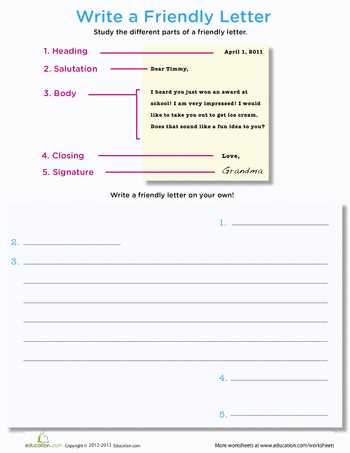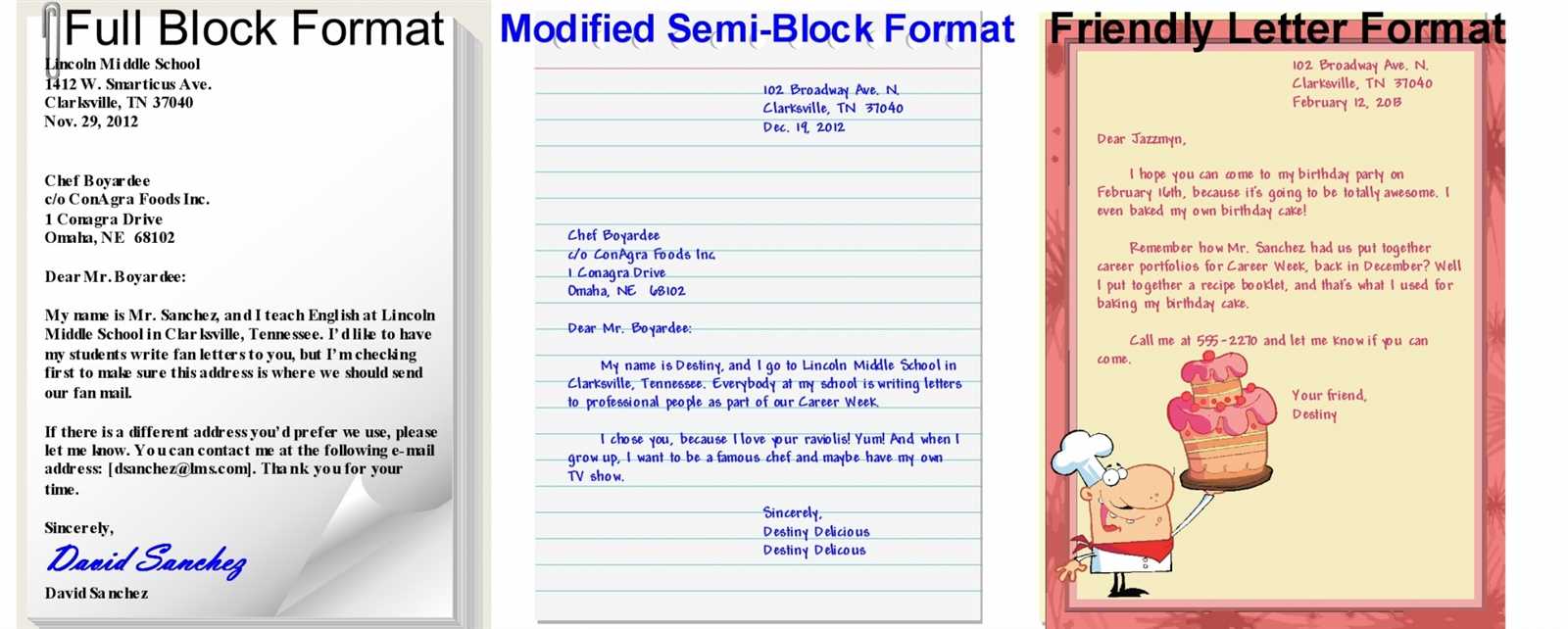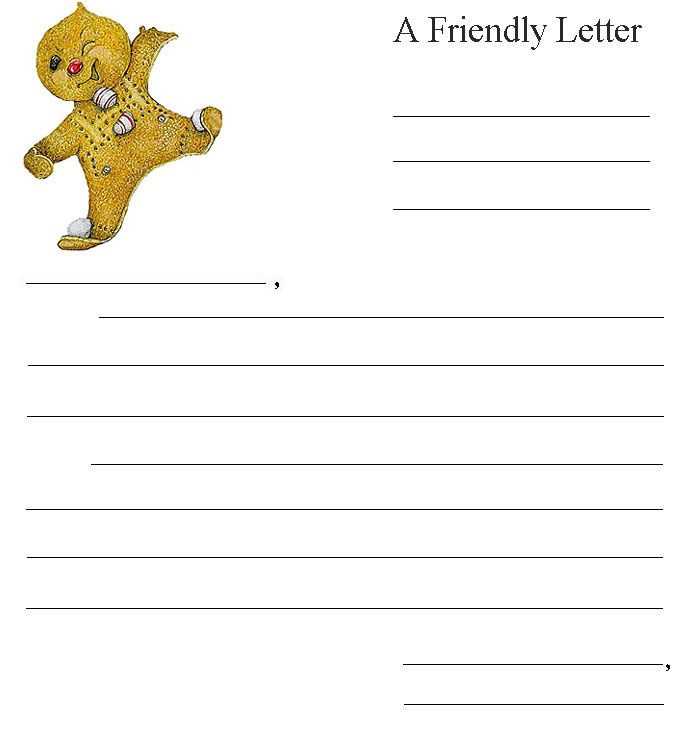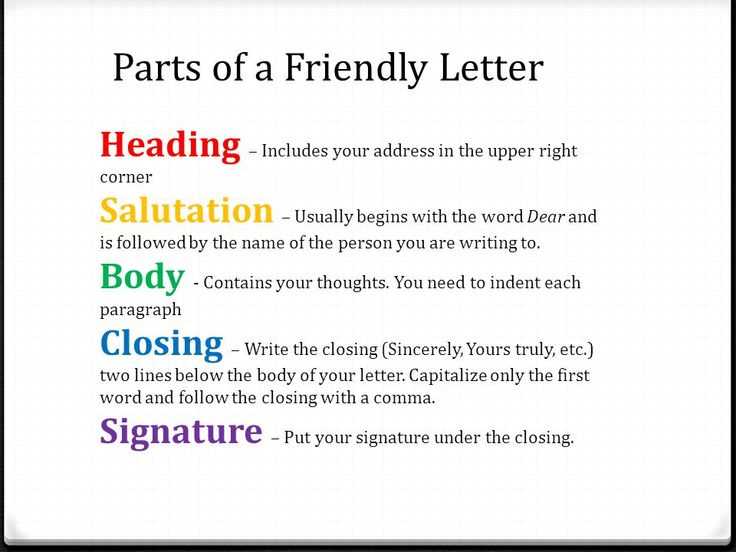How to Write a Friendly Letter Template

Expressing thoughts in a written form is a timeless way to communicate with others. Crafting a personal note can be a thoughtful and meaningful gesture that strengthens connections. Whether it’s a casual update or a heartfelt message, understanding the basic structure can make your words more effective and impactful.
Having a clear outline is essential when constructing a personal message. Knowing how to start, develop, and conclude your note ensures that it flows naturally and conveys your intentions clearly. By following a few key steps, you can compose a well-organized communication that feels personal and genuine.
It’s important to consider the tone and style you want to use in your correspondence. Depending on the relationship and the occasion, your message may vary from informal to more formal, but each one should reflect your unique voice and personality. By adapting your approach, you can ensure that your message resonates with the recipient.
Sending a thoughtful message can greatly enhance personal connections. It allows you to convey emotions, share experiences, and maintain relationships. A well-crafted note provides a sense of warmth and intention, showing the recipient that you care enough to reach out and engage with them.
Communication is an essential part of any relationship, and expressing oneself in a written form adds a personal touch. Unlike digital chats or quick texts, a more deliberate message often carries a deeper meaning. Taking the time to compose such a message shows respect for the recipient and the bond you share with them.
In both personal and professional settings, sending a heartfelt note helps strengthen ties. Whether it’s to express gratitude, offer support, or simply stay in touch, a written message can bridge distances and ensure the continuity of meaningful connections.
Key Parts of a Personal Letter

When crafting a meaningful note, it’s essential to consider the core elements that make it both structured and engaging. These components ensure that your message is clear, organized, and able to convey the intended emotions effectively. Each part plays a unique role in guiding the reader through your communication.
The opening serves as an introduction, where you address the recipient in a way that reflects the relationship you share. Whether it’s a warm greeting or a more formal salutation, this sets the tone for the rest of your message.
The body is where the main content of your message resides. Here, you express your thoughts, share details, or offer updates. It’s important to keep the flow natural and maintain a personal yet clear approach. This section provides the heart of your message and ensures the recipient understands your intentions.
The closing brings your note to a thoughtful end. It’s a way to reiterate your sentiments, offer well-wishes, or leave the door open for further communication. Ending your message with sincerity ensures that the reader feels valued and appreciated.
How to Craft an Informal Note
Creating a casual and personal message involves a balance between warmth and simplicity. It should feel natural, allowing your personality to shine through while still being clear and engaging. The goal is to convey your thoughts without overcomplicating the process, keeping the tone relaxed and approachable.
1. Start with a Friendly Greeting
The way you begin sets the tone for the entire message. Choose a greeting that reflects your relationship with the recipient. It could be a simple “Hello,” or something more playful like “Hey there!” depending on how close you are.
2. Share Your Thoughts Clearly
In the main body of your note, focus on expressing what you want to share. This could be an update, a question, or just a friendly message. Make sure to keep your sentences clear and avoid long, complicated phrasing.
- Keep your tone relaxed and easygoing.
- Feel free to add personal touches, like humor or inside jokes.
- Stay direct, but don’t be afraid to be a bit informal and lighthearted.
3. End with a Warm Closing
Finish off your message with a warm conclusion. You can express anticipation for a response or simply offer a friendly sign-off, like “Take care” or “Looking forward to hearing from you soon.”
Selecting the Best Tone and Approach
Choosing the right style for your message is key to ensuring that your words are well received. The tone you adopt can influence how your message is understood and how the recipient feels about it. A thoughtful approach helps convey the right emotions and fosters a positive response.
Understanding the Context
Before crafting your message, consider the relationship you have with the person and the purpose of your communication. Is it a casual update or a more meaningful expression? Your approach should align with these factors to ensure the message feels authentic.
Adjusting Your Tone
Depending on the formality of the situation, you can decide whether to take a more relaxed, playful tone or a slightly formal one. For a casual connection, a conversational and warm approach works well. On the other hand, if the situation requires respect or professionalism, a more composed tone may be needed.
- Keep your tone natural and genuine.
- Match your choice of words to the level of intimacy with the recipient.
- Stay mindful of your message’s emotional impact.
Samples of Casual Letter Templates
Below are examples of informal communication structures that can be adapted to different situations. These samples can help guide your own messages, ensuring that they remain approachable while conveying the intended information in a clear and engaging way.
Sample 1: Checking In with a Friend
Here is a simple example for reaching out to a friend and sharing a casual update:
- Greeting: “Hey [Friend’s Name],”
- Opening: “I hope you’re doing well!”
- Main content: “I just wanted to catch up and see how things are going. It’s been a while since we last spoke, and I’d love to hear about what you’ve been up to.”
- Closing: “Looking forward to hearing from you soon. Take care!”
Sample 2: Sending Thanks for a Kind Gesture

This sample can be used to express gratitude for a thoughtful action or gift:
- Greeting: “Dear [Name],”
- Opening: “I just wanted to say thank you for [specific action]. It truly meant a lot to me.”
- Main content: “Your kindness really brightened my day, and I am so grateful for having someone as thoughtful as you in my life.”
- Closing: “Thanks again! Hope to catch up soon.”
Common Pitfalls to Avoid When Writing
Creating a meaningful and effective message involves more than just the right words; it’s also important to avoid common mistakes that can hinder communication. Awareness of these pitfalls ensures that your message is clear, well-received, and conveys the intended tone.
1. Overcomplicating the Message

One of the most frequent mistakes is trying to use complex language or overly detailed explanations that can confuse the recipient. Keep it simple and to the point.
2. Using Inappropriate Tone
The tone should match the relationship you have with the person. Avoid being too formal when it’s unnecessary or too casual when a more respectful approach is needed.
| Common Mistakes | How to Avoid Them |
|---|---|
| Overuse of slang or jargon | Choose clear and simple language, especially if the recipient may not be familiar with the slang or terms. |
| Lengthy and unnecessary details | Stick to the main message and avoid irrelevant details that might distract from your point. |
| Unclear closing | Finish with a clear and appropriate sign-off, such as “Best regards” or “Talk soon.” |